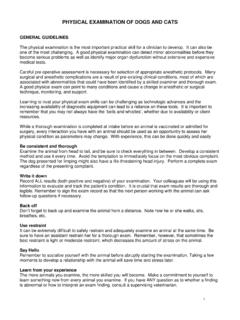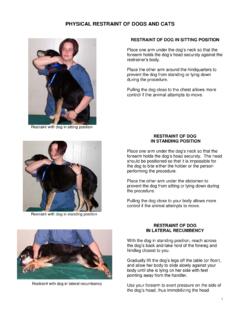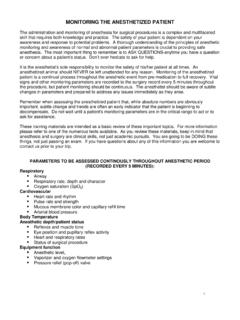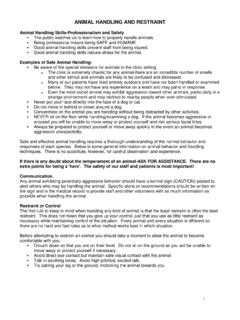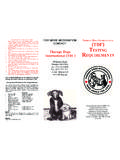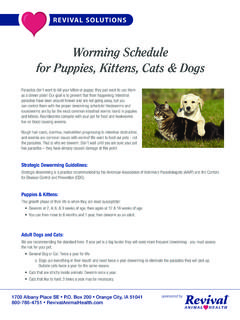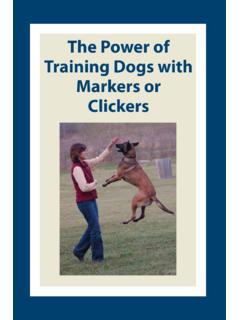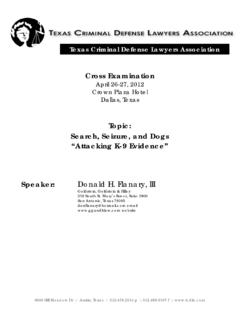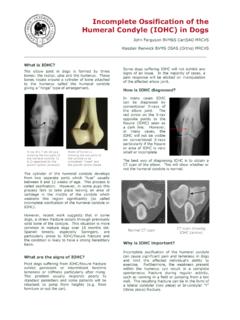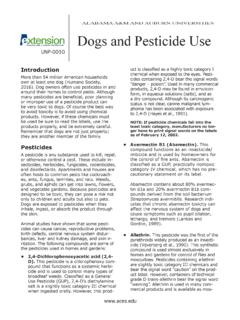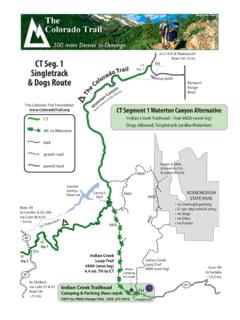Transcription of ANIMAL HANDLING AND RESTRAINT - RURAL AREA VET
1 1 ANIMAL HANDLING AND RESTRAINT ANIMAL HANDLING Skills-Professionalism and Safety The public watches us to learn how to properly handle animals. Being professional means being SAFE and HUMANE. Good ANIMAL HANDLING skills prevent staff from being injured. Good ANIMAL HANDLING skills reduce stress for the ANIMAL . Examples of Safe ANIMAL HANDLING : Be aware of the special stressors for animals in the clinic setting. The clinic is extremely chaotic for any ANIMAL -there are an incredible number of smells and other stimuli and animals are likely to be confused and distressed.
2 Many of our patients have lived entirely outdoors and have not been handled or examined before. They may not have any experience on a leash and may panic in response. Even the most social ANIMAL may exhibit aggression toward other animals, particularly in a strange environment and may redirect to nearby people when over-stimulated. Never put your face directly into the face of a dog or cat. Do not move in behind or crowd around a dog. Concentrate on the ANIMAL you are HANDLING without being distracted by other activities.
3 NEVER sit on the floor while HANDLING /examining a dog. If the ANIMAL becomes aggressive or aroused you will be unable to move away or protect yourself and risk serious facial bites. Always be prepared to protect yourself or move away quickly in the event an ANIMAL becomes aggressive unexpectedly. Safe and effective ANIMAL HANDLING requires a thorough understanding of the normal behavior and responses of each species. Below is some general information on ANIMAL behavior and HANDLING techniques. There is no substitute, however, for careful observation and experience.
4 If there is any doubt about the temperament of an ANIMAL -ASK FOR ASSISTANCE. There are no extra points for being a 'hero'. The safety of our staff and patients is most important! Communication Any ANIMAL exhibiting potentially aggressive behavior should have a kennel sign (CAUTION) posted to alert others who may be HANDLING the ANIMAL . Specific alerts or recommendations should be written on the sign and in the medical record to provide staff and other volunteers with as much information as possible when HANDLING the ANIMAL . RESTRAINT or Control The first rule to keep in mind when HANDLING any kind of ANIMAL is that the least RESTRAINT is often the best RESTRAINT .
5 This does not mean that you give up your control, just that you use as little RESTRAINT as necessary while maintaining control of the situation. Every ANIMAL and every situation is different so there are no hard and fast rules as to what method works best in which situation. Before attempting to restrain an ANIMAL you should take a moment to allow the ANIMAL to become comfortable with you: Crouch down so that you are on their level. Do not sit on the ground as you will be unable to move away or protect yourself if necessary.
6 Avoid direct eye contact but maintain safe visual contact with the ANIMAL Talk in soothing tones. Avoid high-pitched, excited talk. Try patting your leg or the ground, motioning the ANIMAL towards you. 2 TYPES OF RESTRAINT VERBAL RESTRAINT : Many dogs know some commands or can at least recognize authority, even if the command is unfamiliar. Commands such as SIT, STAY, COME, DOWN, NO or even HEEL may be useful tools to encourage a dog to cooperate. Also, soft quiet words can calm a frightened ANIMAL . Yelling or screaming should never be used as it can cause the ANIMAL to become more fearful or aggressive.
7 PHYSICAL RESTRAINT : TOOLS AND EQUIPMENT Leash: The most common tool used to handle animals in the clinic is the leash. Placed around a dog's neck it normally controls even the largest dog. In the event a dog refuses to cooperate with a leash carry him. Some dogs have never seen a leash and will freeze up to the sensation around a sensitive area like the neck. Leashes can be abused; never drag or strangle an ANIMAL with a leash; if the ANIMAL starts to struggle, pulling and jerking away from you, she is probably not leash trained.
8 Pause and let the dog calm down and try again after reassuring her. Sometimes a quick tug on the leash will encourage a fearful dog to walk. If the dog refuses to walk, apply a muzzle (if necessary) and carry her. When HANDLING cats, a leash should be used as a back-up in the event the cat should become frightened and resist RESTRAINT . Make a figure-eight harness by looping the free end of a slip lead back through the metal ring. The looser loop is placed around the chest behind the cat s front legs and the other loop placed around the neck with the metal ring/handle on top between the shoulders.
9 This will prevent the cat from escaping or injuring someone should she get loose from your RESTRAINT . The harness should be put on at intake and can be left on the cat throughout their stay. EVERY ANIMAL being transported or handled in the clinic must ALWAYS wear a slip-lead. This includes puppies, cats and sedated animals. It is too easy for a frightened ANIMAL to get loose and escape. Animals presented on leash/collar should be transferred to a slip lead and the leash returned to the client so that it is not lost during the ANIMAL s stay.
10 Your hand: A very effective form of RESTRAINT , your hands are sensitive to the amount of pressure that is being exerted on the ANIMAL and can be quickly modified to the situation. Hands can be used to gently stroke a dog or to firmly grasp a struggling cat. Although hands can be the most versatile, they are also the most vulnerable to injury. Recognizing when they would not be effective is very important. Towels: A towel or blanket is a very useful tool for cats and small dogs. A towel can be used to decrease an ANIMAL s arousal by covering the head and body and can help protect from sharp claws.
